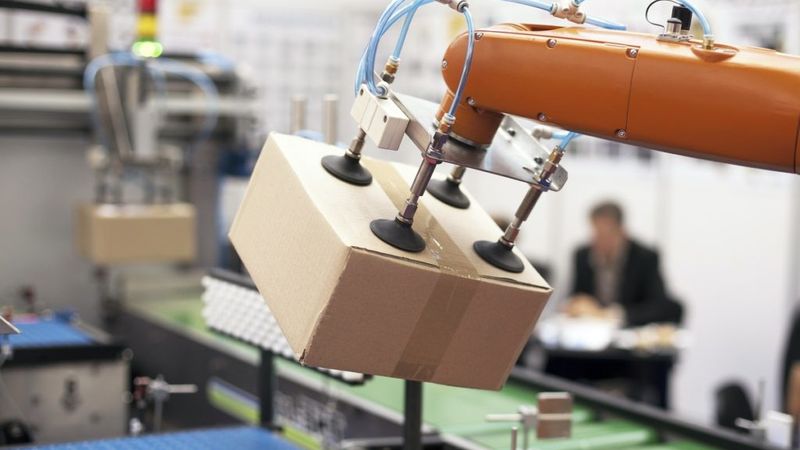Guide to End-of-Line Robotics: Packaging & Palletizing Robotic Automation
Over the past 50 years, the manufacturing industry has undergone a complete transformation with the introduction of automation and industrial robotics.
The complete guide to end-of-line packaging and palletizing with robots
Over the past 50 years, the manufacturing industry has undergone a complete transformation with the introduction of automation and industrial robotics. Factories that had previously relied on manual operations are now increasingly turning to intelligent robots to drive efficiencies, increase safety, and reduce costs throughout the entire production process. For companies that are considering semi-automation or end-to-end automation, it is worth exploring new end-of-line (EOL) robotics technologies that can significantly increase production rates and cost-effectiveness.
In this guide, we deep dive into two specific areas of industrial robotics – end-of-line packaging and palletizing.
What is robotic end-of-line packaging?
Robotic end-of-line packaging (EOLP) refers to the ability to use robots to package a variety of items into boxes, cartons, cases or crates. With consumer demand growing for faster production and delivery times, packagers are deploying more robotic tools to automate end-of-line tasks and drive more productivity.
Pick-and-pack robots are commonly used for end-of-line packaging applications. These are robots that can identify, sort and select specific objects on a conveyor belt using integrated vision systems, and then place them into a box. Packing robots often have a robotic arm equipped with an end-of-arm tool (EOAT) that enables them to pick and pack items so precisely that even delicate products like eggs aren’t damaged.
According to a 2017 report published by Allied Market Research, the global packaging robot industry is expected to reach $4,649 million by 20231.
What is robotic end-of-line palletizing?
Robotic end-of-line palletizing refers to the ability to use robots to palletize, or store and transport goods stacked on a pallet. Robotic palletizers also have an EOAT that can grab one or more specific goods from a conveyor belt and position it on a pallet. Goods to be placed on the pallet can include boxes, trays, bags, bottles or kegs.
Advanced robotic palletizing systems have the ability to palletize multiple production lines simultaneously, even in the same production space, thus significantly reducing costs and increasing outputs.
Additional components of a robotic palletizer include:
- Infeed and outfeed conveyors that deliver products to the palletizer, and then take the fully stacked pallets away
- Pallet dispensers that extract single pallets for the palletizer
- Automatic slip sheet dispensers, used when needed
Benefits of robotic end-of-line packaging & palletizing
Return on investment (ROI) for end-of-line robotic automation is high. There are many benefits of robotic end-of-line packaging and palletizing, including:
- Increased productivity and flexibility: End-of-line robots can produce output more efficiently and quickly compared to manual production efforts, and offer more flexibility to automate multiple production lines simultaneously.
- Increased quality control: With automated inspection, robots can reliably minimize the likelihood of product damage and product handling errors. On average there are 10x fewer failure opportunities with robots2.
- Improved utilization of skilled labor: By deploying automated robots, skilled laborers can be freed up to work on more valuable, non-automated production processes.
- Increased safety: Industrial robots can ensure adherence to occupational safety standards and eliminate the need for workers to be stacking and lifting heavy packages. This results in fewer labor injuries and ergonomic issues.
- Quicker changeover: With automatic tool changers, robots can minimize (or eliminate) product changeover, which is the process by which the configuration of equipment settings is changed from one product to another.
- Greater ease of use: Many modern packaging and palletizing robots now have very user-friendly interfaces with advanced sensing software that make them easier to operate.
- Less factory footprint: Robotic automation tools require on average 15% less factory footprint compared to traditional packaging and palletizing systems1.
- Decreased maintenance: End-of-line robots for packaging and palletizing typically require greasing every 6 months to 3 years and annual battery changing. Though this may vary between different robot brands and can be a warranty item, on average, the number of components to maintain with robots is significantly less.
Which industries use robotics for end-of-line production?
According to the Robotic Industries Association, “Robots have become more dexterous, safer, and available in a variety of form factors. They have become more appealing to new users in a wide variety of industries3.” On top of the pressure mounting to produce more and more efficiently in today’s competitive global economy, it’s no wonder that almost all manufacturing industries are implementing robots for end-of-line production.
In the 1980s, the automotive industry especially embraced robotic manufacturing throughout its entire production process. Since then, robots are now used for the packaging and palletizing of products in a wide variety of industries including food and beverage, electrical, hardware, healthcare and medical, household products, industrial goods, paper products, personal care, pet products, pharmaceutical, and technology industry.
When to consider end-of-line robotics
Any company that produces a product – especially multiple products or large products that are placed on shipping pallets – should explore the benefits of end-of-line robotic automation. Robotics can give you the flexibility to produce multiple product lines simultaneously, reduce costs, and increase output and safety – all while using less factory space.
Robotics can also help companies facing operational challenges, like those who are dealing with frequent market-driven changes to their products and there is not enough time to ramp up for changeovers.
Don’t be afraid of the common misconceptions that industrial robots are all expensive or too complex. Today, there are a myriad of end-of-line solution providers that can help address your challenges reliably, simply, and with high, long-term ROI.
1. Bose, Deepankar. “Packaging Robots Market Is Expected to Reach $4,649 Million, Globally, by 2023.” Allied Market Research. Web
2. “Robotic Packaging Automation Considerations.” Robotic Industries Association. September 2006. Web
3. “North American Robotics Orders to Non-Automotive Companies Surge to New Records.” Robotics Online. Robotic Industries Association. November 2018. Web
